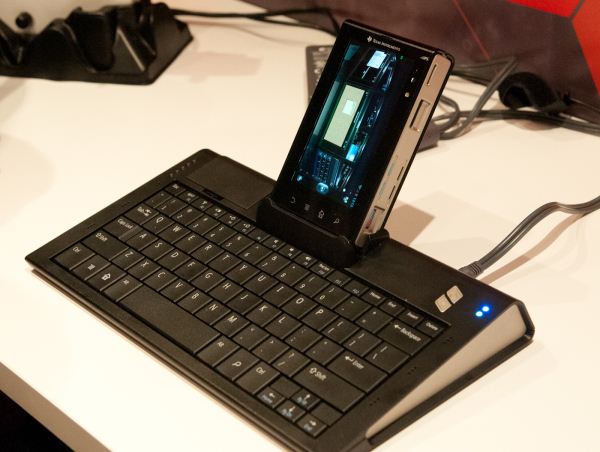TI Demos OMAP5 WiFi Display Mirroring on Development Platform
by Brian Klug on March 1, 2012 4:04 PM EST- Posted in
- Smartphones
- Mobile
- WiFi
- OMAP 5
- MWC 2012
On our last day at MWC 2012, TI pulled me aside for a private demonstration of WiFi Display functionality they had only just recently finalized working on their OMAP 5 development platform. The demo showed WiFi Display mirroring working between the development device’s 720p display and an adjacent notebook which was being used as the WiFi Display sink.
TI emphasized that what’s different about their WiFi Display implementation is that it works using the display framebuffer natively and not a memory copy which would introduce delay and take up space. In addition, the encoder being used is the IVA-HD accelerator doing the WiFi Display specification’s mandatory H.264 baseline Level 3.1 encode, not a software encoder running on the application processor. The demo was running mirroring the development tablet’s 720p display, but TI says they could easily do 1080p as well, but would require a 1080p framebuffer to snoop on the host device. Latency between the development platform and display sink was just 15ms - essentially one frame at 60 Hz.
The demonstration worked live over the air at TI’s MWC booth and also used a WiLink 8 series WLAN combo chip. There was some stuttering, however this is understandable given the fact that this demo was using TCP (live implementations will use UDP) and of course just how crowded 2.4 and 5 GHz spectrum is at these conferences. In addition, TI collaborated with Screenovate for their application development and WiFi Display optimization secret sauce, which I’m guessing has to do with adaptive bitrate or possibly more.
Enabling higher than 480p software encoded WiFi Display is just one more obvious piece of the puzzle which will eventually enable smartphones and tablets to obviate standalone streaming devices.











3 Comments
View All Comments
SlyNine - Friday, March 2, 2012 - link
I would love to see remote desktops running VMs in a personalized cloud. If us normal folks could virtualize our graphic cards, or give the VM access to one GPU in a multi GPU computer we could have some cost effective lan gaming systems and we could also use our netbooks and Ipads to play games where ever when ever.SlyNine - Friday, March 2, 2012 - link
let me rephrase, I would love to see some a computer/small server running VM's remote desktoping to dumb devices like a personilzed cloud.kjboughton - Saturday, March 3, 2012 - link
You can. What you're looking for is already offered by MS using Server 2008 R2 SP1 and their Hyper-VM service. The feature is called RemoteFX and it works by providing virtualized access to the host system's underlying GPU farm, accelerating audio and video over a Remote Desktop link to the client. DirectX, OpenGL, and Aero are all supported with using the RDP 7.1 protocol. It works both locally via a LAN as well as over WAN, WLAN, etc.